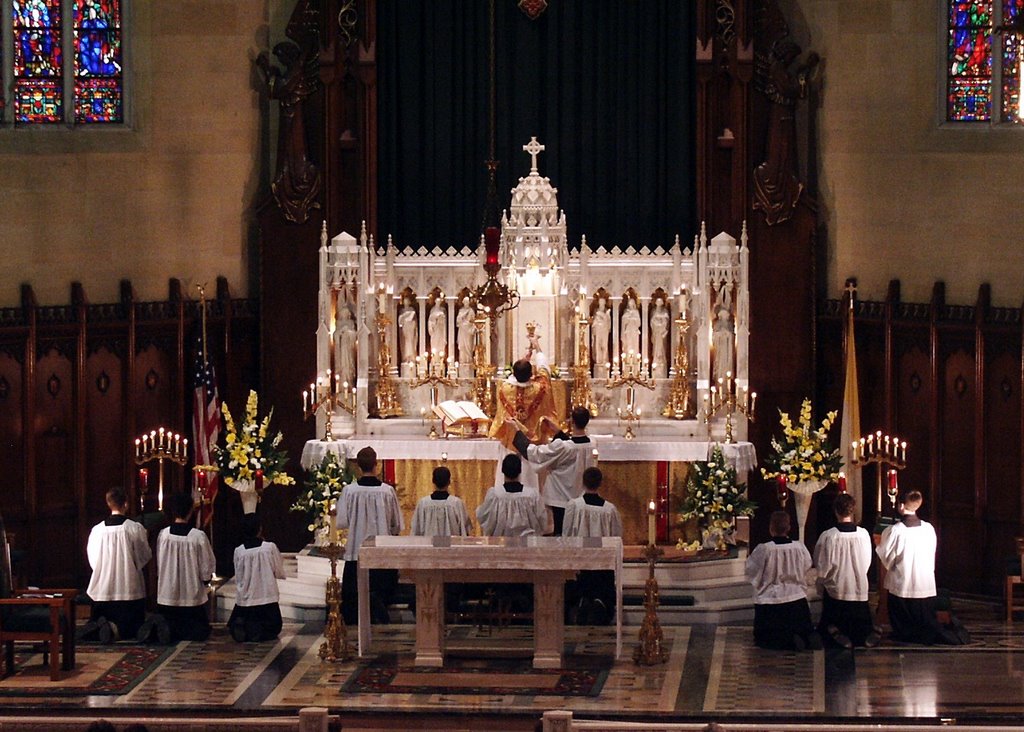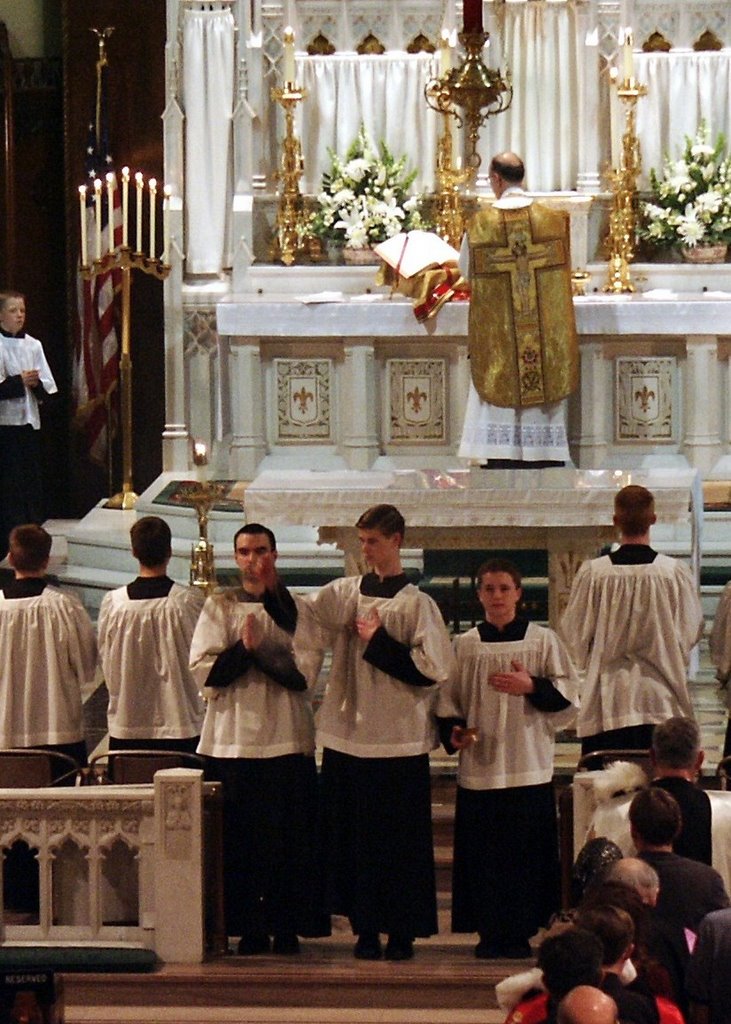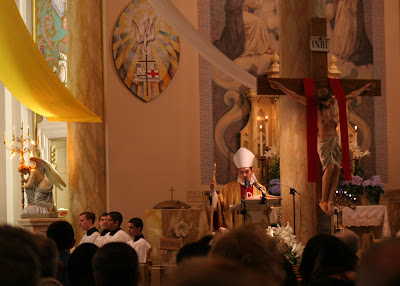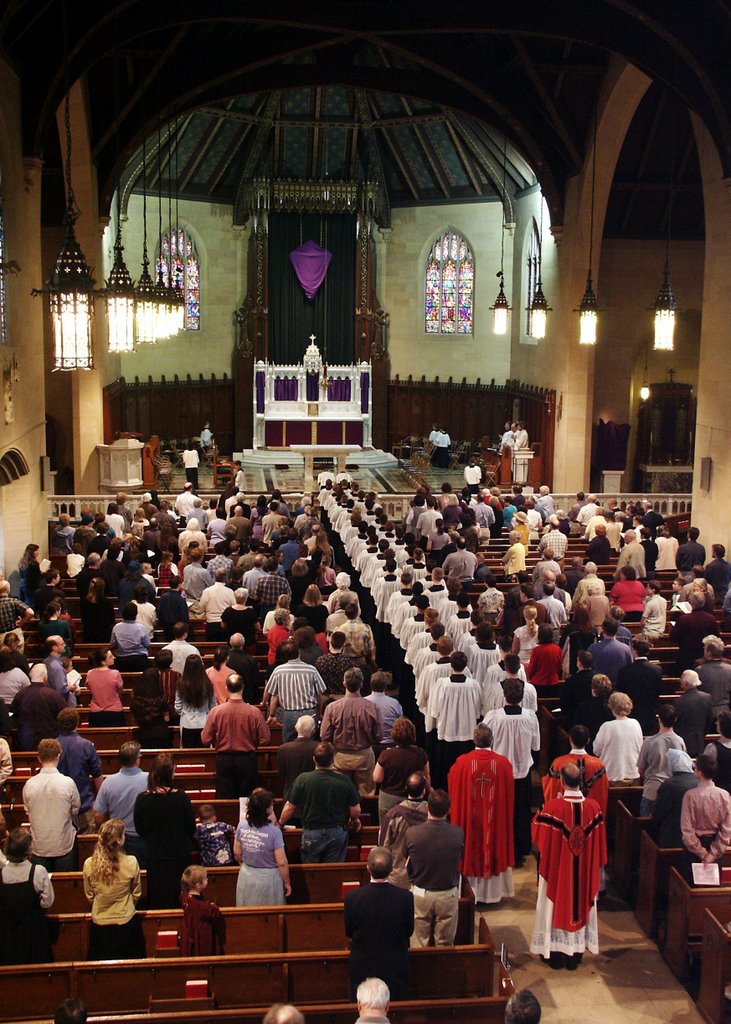
We continue with our discussion of the altar boy program at Assumption Grotto, and my theories for why it enjoys significant participation. In yesterday's introductory post to this series, I provided a list along with some necessary background information (click the first link in the list for that post).
I apologize for the length of these posts, but there is truly much to be said about each of these areas. I'll try to slow posting to allow you time to disgest what is here - barring breaking news. I also have more Easter photos to go through, but a glitch in my computer is holding me up.
I invited participation in the comment boxes of these posts - but asked that those comments go in the related posts - some not yet written.
I've jumbled the order a little, as I began to see that one subject will lead into the next.
- All Male Program.
- Masculinity of Discipline and Precision Required
- Headed by the pastor; priestly involvement
- Liturgically traditional parish with orthodoxy in doctrine
- Strong Catholic identity within the family
- Large homeschooling population
2) Masculinity of Discipline and Precision Required
While the pictures I take show interesting formations by the altar boys, there are many things that cannot be conveyed in photos. There is an air of discipline to what they do and there is a high level of precision. When you realize that some of these boys are just 7 or 8 years of age and see them exercise this discipline and precision for an hour or hour-and-a-half, as in the Latin Novus Ordo, it's all the more amazing. It also goes to show that such an age is not too young to learn discipline and precision.
Example of a Poorly Catechized & Trained Altar Server
I was recently at another parish in which there was a single, male altar server. In the processional, he walked with a hip strut, his head bobbing around as he nodded and winked at people he knew along the way. Throughout the readings he looked up and around, visibly distant from what was taking place. Just before heading into the Eucharistic Prayer, he turned to look at his family behind him and began to giggle and shrug his shoulders, as they too laughed. After the great Amen, he rose from his knees and continued to look back a few more times. It must have been an inside joke because no one else was laughing.
The only reason I noticed this activity is that it was distracting since he was right at the center of action. The boy was about 16. I wasn't upset with him, but pitied the young man because he was not taught properly. He was also functioning in a parish where people - the assembly, is still central. This boy did not understand that in the presence of the Holy of Holies, all things should point to His centrality, not ours. This means, removing any action that would take people's focus from Our Lord during the Mass to humans - be it the priest or anyone else in the Sanctuary. I humbly offered my Communion for him, the pastor, and the people of the parish and asked the Lord to "forgive the boy as he knows not what he does".
Discipline and Focus in Assumption Grotto's Atlar Boys
The first thing I noticed two years ago about the altar boys with regards to discipline is that they are focused. This means, they do not look detached from what is going on (the very young may not look as focused, but I had no idea a 7 or 8 year old could even look that attentive during the Mass).
The young men look straight ahead when walking and when sitting for the most part. They do not stare at the ceiling. They do not look at or acknowledge people they know in the pews, or other such behavior. Their demeanor mimics that of the priest who is intensely focused and seriously prayerful as the Mass, and procession begin. It's a reminder of where we should be - in deep prayer, not in a greeting mode. That belongs in the social hall following Mass for those who love their neighbor enough to do so.
Visible in Display of Reverence
The walk of experienced altar boys is slow and dignified, especially when walking around the sanctuary. They have been taught before Whom they walk and it shows in how they carry themselves. Once again, the exception is some of the very young who might dart kind of fast, which always catches the eye. The experienced ones often pass unnoticed with their slow movements. In just two years, I've seen young boys mature in this regard.
 They do not pass the Tabernacle without genuflecting before Our Lord, even if this means many genuflections in a matter of minutes, such as when preparing the altar or lighting candles. There are no exceptions, other than when they are carrying something which makes it too difficult or awkward to genuflect, at which time they offer a profound bow.
They do not pass the Tabernacle without genuflecting before Our Lord, even if this means many genuflections in a matter of minutes, such as when preparing the altar or lighting candles. There are no exceptions, other than when they are carrying something which makes it too difficult or awkward to genuflect, at which time they offer a profound bow.
When the altar boys depart from helping the priest, they step back (in unison if more than one), and they make a profound bow before the priest and he returns a slight bow. Incense, used weekly at the Latin Novus Ordo, also provides an opportunity to see the slow, disciplined cadence of the altar boys at work. Even as they incense the congregation, they bow and the people bow back (thought lately, the congregation seems to be "off" by rising before the young men actually get to the opening in the rail). They incense and bow again and the people return the bow.
Discipline in Behavior
Being an altar boy at Assumption Grotto takes serious self-discipline and self-control. They are there early - at least 15 minutes. But I've seen many getting there 30-45 minutes before Mass prepping things, and sitting or kneeling out in the Sanctuary - doing pre-Mass prayers, etc.
Self-discipline includes being worthy to receive Communion and honoring the 1 hour fast. It is not uncommon to see some lined up taking advantage of pre-Mass Confession. Priests at my parish, like the CCC, encourage everyone, but especially altar boys, to make frequent confessions even in the absence of serious sin. It builds holiness in life.
I hope I have not misrepresented our altar boys as less than human. I do not intend to make them appear as saints. Parishioners have told me "stories" - leaving out names of course, of just how serious discipline is at the altar. The boys are convinced our beloved pastor, Fr. Perrone, has eyes in the back of his head, but consider that he is sometimes in the loft chanting during masses he does not celebrate (and being in the loft with him - shooting photos or singing with the choir, I can assure you he doesn't go out of his way to "catch" anything as he is usually praying). But, if an altar boy is caught laughing and giggling during Mass, he may very well earn himself a suspension. With most of the parish's boys in the program, getting suspended is the equivalent of a ball player getting benched. However, I have never gotten the impression that there is fear in any of the young men. Rather, they know this is serious business and it's most visible in the more seasoned and mature. Some go on to serve in adulthood.
Is all of this too rigid? Hardly! There is a time for laughter and goofing around (Fr. Perrone is not some stern figure, incapable of laughs and games. Rather, they are meant for the church hall and not for the church).  It is on the altar that the Body and Blood of Our Lord Jesus Christ is confected. At any one time, the boys are just mere feet from Jesus in the Blessed Sacrament. They are taught to respect the Real Presence in ways I never was. Now, these disciplined boys teach me about discipline and reverence. Their actions had me "see" my sloppy stance (yeah, I was once the lady with my arms suspended on the back of the pew like it was a park bench). Their genuflecting had me looking closer at my own irreverence. In the end, what I discovered about my behavior in Church led me to realize that I myself did not get it before I came to Grotto. It is OUR LORD up there. The disciplined behavior of these fine young men teaches us this.
It is on the altar that the Body and Blood of Our Lord Jesus Christ is confected. At any one time, the boys are just mere feet from Jesus in the Blessed Sacrament. They are taught to respect the Real Presence in ways I never was. Now, these disciplined boys teach me about discipline and reverence. Their actions had me "see" my sloppy stance (yeah, I was once the lady with my arms suspended on the back of the pew like it was a park bench). Their genuflecting had me looking closer at my own irreverence. In the end, what I discovered about my behavior in Church led me to realize that I myself did not get it before I came to Grotto. It is OUR LORD up there. The disciplined behavior of these fine young men teaches us this.
When there is interior reverence, it is manifested in exterior reverence! That reverence stems from knowing before Whom we stand, walk, and kneel.
Precision in Execution
The boys are very knowledgeable about tools of the trade and of actions that need to be performed. Dressed in cassock and surplice, they line up from smallest to tallest. Cross and candles are carried in the opening procession, as is incense when it is being used.
Formations are a real site to see. As the Sanctus is being sung, 5 boys enter the Sanctuary - 3 from one side - 2 from the other, and they cross paths in a beautifully choreographed manner. One will be handling the thurible with incense. There's no thinking involved, it is just second nature to them, but from afar - oh so beautiful. It signifies the grace of the moment. The smaller boys come out holding red-glass candle holders suspended on poles (see the photo at top). As the bells are rung signaling the entry into the most sacred part of the Eucharistic Prayer, one of the older 5 boys will rise, genuflect, then proceed up the steps to take hold chasuble from behind. As the Body and Blood of Christ are elevated, the chasuble is lifted as the thurifer swings the thurible. Elevation is prolonged as bells ring out and incense rises upward with the smell of sweetness reminding us that our worship is pleasing to God.
In processions - including those outdoors - there are often two thurifers. As they process, one will be turned towards the Blessed Sacrament, walking backwards, while swinging the thurible three times. He then turns forward, and the other thurifer turns around, walks backward, and does the same. This process repeats itself over and again.

Corpus Christi 2006
The Masculinity of it All
This kind of discipline - self and group discipline, as well as the precision, is masculine. It's not only manly for the young men who participate, but for the men who come to Mass. As a female, I am also more comfortable with the power, the strength, the majesty and the awe of it all.
I have read articles about how men are largely absent in the pews in contrast to females these days. I recall all too vividly when, in my childhood parish, the Stations of the Cross were taken down, and in their place were hung these paganistic, metal "pansies". Potpourri took the place of candles and felt banners adorned every corner. Gold, silver and brass was ousted in favor of wood, wicker and clay. Thankfully, the current pastor of that parish fixed those things quickly when he came into the parish (along with several other things which needed fixing). Is it any wonder why there are fewer men involved at church when all things liturgical have been emasculated?!?
The actions of the boys is much like what we would see in sports or in military exercises (but, there is no "marching" and movements are more humble in nature). This, I believe, is one factor making it appealing to boys. As I've said before, this is their "baby". They own it!
While they are at the center of action, they know they are not to be the center of attention. In the beginning when you first come to Grotto, it is so unusual to witness their activity that it does initially become a distraction. But something happens after being around it for awhile. Their disciplined, cadenced motions cause them to fade from our awareness, unlike the actions of the young man who was seen giggling at the service of the altar in the opening of my post.
For me, it is this unchanging element that allows them to fade into the backdrop of the liturgy. During the Elevation, they enhance my experience by silently gracing the scene with their profound display of adoration. The "wall" and near pyramid-like formation they make at solemn events reminds me that Our Lord is not only the Source of our life, but the Summit!
Witnessing the altar boys at work at Assumption Grotto lifts my soul to grasp what is taking place. It all says, "Holy, Holy, Holy!"



































